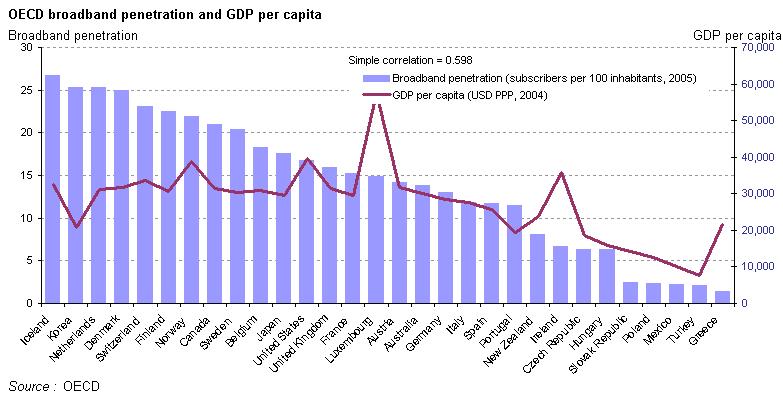Difference between revisions of "Trends in Broadband"
| Line 22: | Line 22: | ||
'''''* Is their a growing distance between countries with a good developed broadband system and conutries with an underdeveloped broadband system?''''' | '''''* Is their a growing distance between countries with a good developed broadband system and conutries with an underdeveloped broadband system?''''' | ||
As we can infere from the graph below, there is a significant correlation (0.6) between the GDP per capital and the broadband penetration. Further, we can notice that the countries at the left side (highest penetration) of the graph are the ones notorious for the widespread of their broadband infrastructure. | |||
[[Image:broadband-gdp.jpg]] | |||
'''''* Will the limited availabilty of broadband in under-developed countries limit their development?''''' | '''''* Will the limited availabilty of broadband in under-developed countries limit their development?''''' | ||
Revision as of 15:24, 17 May 2006
* what broadband techniques will emerge in the future?
- WiMax - BPL
Both forms of broadband delivery could be a real threat to the established DSL and cable operators. However, none of them have been fully implemented yet.
* Will the emerging broadband-over-powerline (BPL) technology be successful?
BPL proposed the use of the existing electrical grid as a giant data network that could form an immediate alternative to Cable and DSL. So far all intents to introduce this service have not been successful. However, it is a genius concept and might represent a real threat to cable and phone companies. BPL companies have started to develop alliances and partnerships with different types of companies to try to implement this concept.
* what are the future opportunities of broadband?
Future Broadband Satellite Networks: next generation multi-beam broadband satellite systems will target high throughput, data transparency, high routing flexibility, small granularity, etc. and at low bit delivery cost. Challenges: travel off data, irreversible delay due to speed of light. costly to implement.
WIMAX: wireless technology enabling broadband over a large area (5km) without any significant infrastructure investment. challenges: security, pierce throught building and transport infrastructure.
* Is their a growing distance between countries with a good developed broadband system and conutries with an underdeveloped broadband system?
As we can infere from the graph below, there is a significant correlation (0.6) between the GDP per capital and the broadband penetration. Further, we can notice that the countries at the left side (highest penetration) of the graph are the ones notorious for the widespread of their broadband infrastructure.
* Will the limited availabilty of broadband in under-developed countries limit their development?
Developing countires can have a lack of information compared to developed countries.
Future development in techniques such as WiMax.....
*What will be the issues raised in mass multimedia download and sharing related to broadband growth?
*When will hardware bottlenecks limit the growth of broadband?
*When will the marginal utility of increased bandwidth be negligible?
In the booming years of computers in terms of speed, the computational speed was doubling every 24 months (Moore's Law [1]) . Thas was the main driver of the evolution of the computers from basic fast calculators to today's life support units. However, the exponential growth of the technology didn't stop because of technological limits, but from the end of common demand. Desktop computers of 2006 can address almost every complicated user needs from DVD editing to broadband applications in a satisfactory speed. The marginal need of additional bandwidth is minimal because it practically doesn't matter whether the user runs an application in 0.1 seconds or 0.05 seconds.
The same pattern is observable also in communication. The first bandwidths were so little that it could only carry minimal amounts of data per day. As the Internet booms and bandwidth capacities increase, more applications were developed that push the limits of the bandwidth consumption. This demand for more complicated applications that require more bandwidth still exists (mobile video telephony, on-demand online DVD rental). However, it is definitely going to stop sometime in 10 - 20 years, when bandwidth increase to more than satisfactory speeds for every common application.
This effectively means that the market in every related sector will reach a saturation point, where satisfactory standards emerge and "a next technological wave never comes". Assuming that all competitors are technologically capable enough to imitate others in terms technological complication, efficiency will be the main driver of the competition in such a market. It may be the case that the marginal utility of new standards are so small that nobody would bother to change to new applications.
*What security problems arise by the combination of fast computational speed limits and broadband communications?
*What problems have to be solved before broadband communication can be used as a substitute to other ways of communication?
